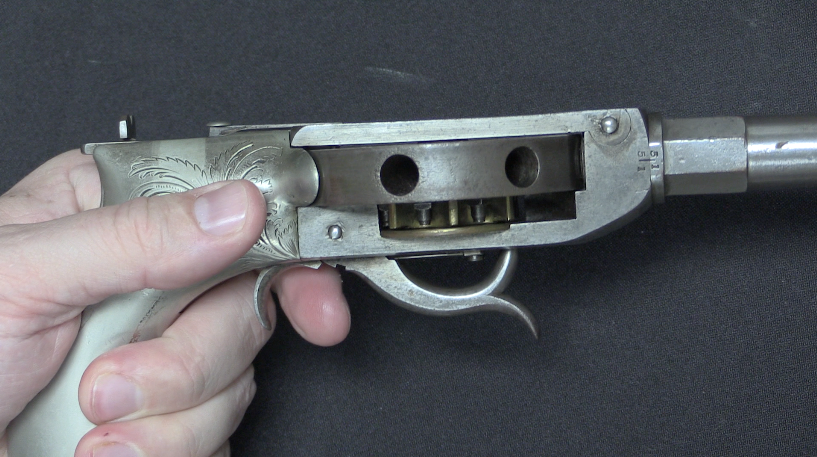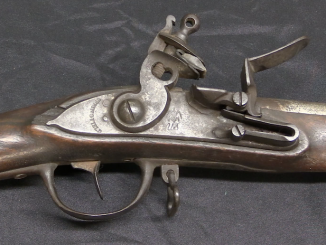Lots 102 (round hammer) and 1416 (spur hammer) in the September 2020 RIA Premier auction.
The 1903 Pocket Hammer was an effort by Colt to adapt the Model 1902 pistol for better civilian sales. They cut the barrel down from 6 inches to 4.5, and used the 7-round magazine and rounded grip frame of the 1902 Sporting model. Production began in 1903, and ran until 1929, when the .38 caliber version of the 1911 was introduced to replace both he Model 1902 and the 1903 Pocket Hammer.
This was never a particularly popular model, with just under 31,000 made in the course of 26 years of production. It was a neither-fish-nor-fowl sort of gun that competed against both the Colt 1908 Pocket Hammerless as a concealable pistol and against the Colt 1911 as a service pistol. On top of that, it was based on the obsolete mechanical system from the Model 1900, which had the possibility of the slide coming off the back of the gun if the slide wedge broke, and offered neither a slide stop nor any safeties (neither manual nor magazine).




This is a sweet example of market saturation gone bad. In the attempt to get something to sell by introducing lots of different models all at once, inevitably several productions will not sell well. The 1903 recoil-operated model was a stepping stone to the 1911, but not a successful step. I could be wrong.
There is also question of advertising. I would hardly say it is pocket with size very close and mass close to Husqvarna Pistol m/1907 service pistol of similar vintage and not having exposed hammer.
Well, it was small enough to hide in an overcoat pocket (like when the user is traveling by train). The phrase “pocket pistol” didn’t refer to a gun that a user would literally stuff into his pants, you know.
1) Was there not even a half-cock? Was there a floating firing pin — could you lower the hammer on a loaded chamber?
2) The Colt locking wedge and the Mauser Broomhandle bolt lock were not dissimilar in size. I suppose both were sturdy enough for one lifetime’s use.
3) There were not just internal competitors like the 1903 pocket Colt — let’s not forget Savage, and after WWI, the original Remington 51, imported Rubys, German war trophies, and of course scads and scads of revolvers for the traditionalist market.
How much did Colt 1903 Pocket Hammer costed when compared to mentioned alternatives, before Great War and in 1920s?
I own a 1903 Hammer model and have always wondered why it was designed without either a safety or a hold open. It is not like the concept wasn’t already being used on the 1903 Hammerless. These omissions may have contributed to the low sale namers.
LDC
In response to your above question; the 1903 Hammer does have a half cock. The slide does Not stay back after the last round is fired.
Thank you. Then it’s at least as safe as a Tokarev, and the magazine won’t fly out of your holster.
As to both the safety and the hold-open, such things cost time and money to develop and install when you’re in a hurry to get to market. Ian Hogg once wrote: “Most modern handguns have a superfluity of safety devices when the best safety is a well-trained user.”
“(…)hold-open(…)”
Would that have much appeal for users accustomed to revolver? Note that for example H&R Auto Pistol https://unblinkingeye.com/Guns/H-R-Auto/h-r-auto.html firing .32 Auto, has not this feature implemented, so it appears it was not treated as must-have in U.S. automatic pistol at that time.
31,000 made in 27 years is pretty small beer. I imagine they would set the tooling up make parts for say 2,000 or so put them into stock to be assembled as and when an order came in and not make any more parts till those in stock were running low.
Ian, a question for you. It is 1910, you are at home in AZ and the Mexican revolution breaks out, being the gentleman adventurer you are you decide to go fight for libertad, what guns would take?
Do you have any documentation of the locking wedge failing? I have examined five of these (all types) specifically looking at the slide for cracks or peaning and have not seen any issues. Admittedly a small sample size. I have never seen a written account stating “serial number xxx broke at the front of the slide”
KOREAN CC/subtitles??? 🙁
Thanks for nipping in with the ‘.38 Super’ explanation. It sounded at first as if ‘.380,’ (.38 ACP) and ‘super’ were interchangeable.
I have one circa 1909 by Colt’s website, with the round hammer. Very nice shooter, more concealable than you might think – keep in mind that the pockets these were supposed to slip in were probably greatcoat pockets, not your windbreaker or Levi’s.
As a 13 year old on a subsistence farm in downeast Maine, I learned to shoot handguns starting with this autoloader with the spur hammer. 55 years later, I still carry a hammer bite scar on the web of my hand. One of our target stands was a junked 1947 Pontiac sedan down over the bank beside the garden; the FMJ 130 grain bullets would punch thru the door metal with ease. When I got my own 1911A1 at 18, I discovered that the 45 slugs just made dents in the same door.
The firing pins on these, as on the Webley .455 automatics, are made of beryllium copper. It would be interesting to learn why.
Beryllium-copper is corrosion resistant but otherwise comparable to spring tempered 1% carbon(+manganese +silicon as de-oxidising agents and to disperse sulphides as blebs rather than having sulphides and oxides causing embrittlement along grain boundaries) steel in tensile strength, hardness and durability.
I’m not sure what the machining characteristics of beryllium copper are. I would guess theyare similar to the aluminium bronzes (excellent) ancient the same for the mechanism/chemistry of the corrosion resistance.
There are several historical points that may bear upon the choice.
To quote a popular late 19th century saying “The Tariff is the mother of trusts”
The Hamiltonian (“American”) system of tariffs and subsidies, robbed American users of steel and protected “trusts” (cartels) of low quality but very high price steel producers
Actors such as Carnegie (probably better known for his post retirement philanthropy and libraries), the Morgan and Mellon financiers and their front man in Pittsburgh, “Judge”Gary…
Were active in shutting competition from overseas out of America, and in trying to cartelise American steel production.
Economics 101 and the supply and demand curves will show that in order to raise prices above the notional equilibrium where the supply and demand curves cross, you have to restrict (reduce) supply
You also have to shut out competition.
The trouble is, as soon as you shut out overseas competition by tariffs and domestic competition by means of labour unions, product quotas, minimum wages and environmental regulations
The cartels become lazy, complacent and generally crappy (look at the cartel of the American 2 party political system for an idea of just how crappy that can get!)
American books and internet forums are always full of questions about the metallurgy and heat treatment of guns that were not made in America
Americans who are interested in guns, tend to be very aware of crappy metallurgy, and for good reason.
America has usually been the home of crappy metallurgy. Thanks to political “protectionism” (towards select cartelised steel makers financed by… and the corresponding aggression towards all users of steel and steel products).
If I remember correctly, use of Beryllium-copper continued at least up to the 1980s and perhaps beyond, for extractors, firing pins and springs in some higher end American guns.
For roles that decent spring alloy steel should be able to perform
Beryllium alloys and Beryllium oxide yield and dust during machining, that is hideously toxic.
I’m not sure whether the European exposure limits have changed recently. It used to be that half a day in a workplace that was within legally accepted exposure limits for airborne beryllia, was enough to give some people crippling lung damage – like needing an oxygen bottle for the rest of their drastically shortened lifespan.
Use of beryllium alloys comes with a very high price.
The question is, why was the high price option of a beryllium alloy used?
I suspect that the argument i gave briefly, is an explanation
Tariffs > cartelised steel makers protected from competition > all users of steel screwed by high price and abysmal quality > users of steel seek alternatives, even ones with hideous health implications for their workers.
“(…)protected “trusts” (cartels)(…)”
Wait. Something does not match timeline-wise. This automatic pistol was made since 1903, mentioned trusts must existed no later than 1890 due to Sherman Antitrust Act of 1890. There is no intersection, so only possibility I see is usage of earlier stock-piled steel.
Apparently, for the same reason that Tokarev (TT 33) was almost accused of sabotage. Because pistols often broke the strikers.
https://www.forgottenweapons.com/accidently-abidextrous-or-hands-on-with-the-colt-1903-pocket-hammer/
Browning used all these tricks like an inertial striker and a forward tilted barrel for a reason.
I had a 1903 Pocket model in the 33,000 range that was a private purchase pistol in NZ about 1914. It was taken to Gallipoli by a Lieutenant in the NZ Engineers and was used in action during the attack on Chunuk Bair, resulting in the award of the Military Cross. It was used by the officer to keep the Turks down while a squad of NZ Engineers under heavy fire tore down a barbed wire obstacle that was holding up the advance. The officer received a rifle bullet that travelled the length of his left forearm but he stayed to protect his men. He subsequently served in WW2 and died in the 1980’s. The .38 Colt Automatic cartridge offered a reasonable performance, slightly superior to the 9mm Para.
Of course.
If it fired, then it could be used as a weapon.
Everything else is a matter of preparation and determination of the user.
The Polish VIS also had a weight and dimensions of .45 with a 9×19 cartridge.
But if you have two identical pistols chambered for 9 and 45, which one will you choose?
It seems that Colt was not very worried about bringing his designs to a good technical level, being content with “acceptable”.
At least I am not aware of any of their weapons that would not have birth defects.
Some of these shortcomings were corrected at the request of the customer (like 1911), others were corrected independently during the licensed deployment (like 1903), and still others were removed from production (like the Mustang).
The rest lived with crooked legs.